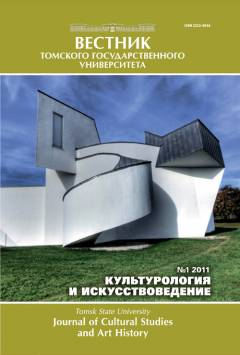The semantics of the image-symbol Time in «Tragic Sonata» op. 39 c-moll by N.K. Medtner
In the modern musicology particular importance are studies the traditions of Russian piano art. In this context, it is necessary to turn to the piano works by Nikolai Medtner, which express the philosophical and aesthetic world of the composer, aimed at protecting the spiritual foundations of music. "Tragic Sonata" (Op. 39-moll) reflects the worldview of the artist, his experience of the tragic events of the era, embodies the ideals and values of Russian culture of the Silver Age. The aim of the study is to analyze the images of time and eternity in the aspect of semantics "Tragic Sonata" and "Morning Song", belonging to the same cycle of works "Forgotten Motives" Op. 39. In the article the following tasks are: to consider the aesthetic and philosophical views of the composer, embodied in the content of symbolic images of Time and Eternity; explore the features and ekstramusical and intramusical semantics in the thinking of the composer; introduce "structural and semantic genre invariant" in "Tragic Sonata". The study of the "Tragic Sonata" by N.K. Medtner based on holistic techniques and semantic analysis. The methodological basis at the semantic analysis of the sonata were works by M.G. Aranovsky, L.A. Kupriyanova, L.N. Shaimukhametova. Studies by E.V. Vasyutinskaya, E.B. Dolin-skaya, K.V. Zenkin, I.Z. Zetel, U. V. Keldysh, O.V. Sokolov, dedicated to the piano works of Nikolai Medtner, helped to analyze the features musical thinking of composer. The material for the study is based on "Morning Song" or.39 G-dur and "Tragic Sonata" or.39 c-moll by N. K. Medtner. The novelty of the work is to understand the deep meaning of the philosophical concept of the sonata c-moll, realized in the dialogue of images Time and Eternity, manifested in dramaturgy and "structural and semantic invariant". For the first time in the analysis of "Tragic Sonata" applied methods ekstramusical and intramusical semantics (M.G. Aronofsky). As a result, disclosed features of the "structural and semantic genre invariant" Sonata of poem-romantic type, where the "Morning Song" is considered as the first part of the lyrical and philosophical, and "Tragic Sonata" is a dramatic ending cycle. In the first part of a two-part composition ( "Morning Song") is represented by the author of Time through the song images symbols of Eternity, the theme of Remembrance. In the second part of the composition - "Tragic Sonata" - presented the lyrical time, expressed in the theme of Destiny. Thus, the semantic content of the main symbolic spheres of Time and Eternity reflect the composer's musical thinking.
Keywords
Н.К. Метнер, фортепианное творчество, «Трагическая соната», «Утренняя песнь», семантический анализ, семантика образов-символов Времени, N.K. Medtner, piano works, «Tragic Sonata», «Morning Song», semantic analysis, the semantics of images and symbols of TimeAuthors
| Name | Organization | |
| Predvechnova Ekaterina O. | Glinka Novosibirsk State Conservatoire | garmonija_nsk@mail.ru |
References

The semantics of the image-symbol Time in «Tragic Sonata» op. 39 c-moll by N.K. Medtner | Tomsk State University Journal of Cultural Studies and Art History. 2017. № 26. DOI: 10.17223/22220836/26/11